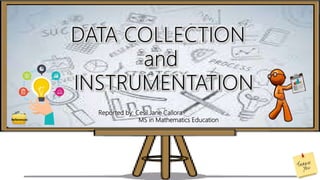
Section 8: Data Gathering and Instrumentation
- 1. Reported by: Cesil Jane Callora MS in Mathematics EducationReferences
- 3. What is Data Collection? • The process by which the researchers collects the information needed to answer the research problem. • In an established systematic fashion that enables one to answer stated research questions, test hypotheses, and evaluate outcomes.
- 4. In collecting the data, the researcher must decide: When to collect the data? Who will collect the data? How to collect the data? Which data to collect?
- 5. Research Instruments • Described as a devise used to collect the data. • Facilitate variable observation and measurement. • The type of instrument used by the researcher depends on the data collection method selected.
- 6. Ways of Searching for Research Instruments • Read professional journals to learn what kind of instruments are being used for similar studies, their format, style and how they are used by the writers. • Read books that provide a description or an actual copy of various instruments for the reader. • Talk with other researchers who may know of certain tools they have developed for themselves, or may have used tools developed by others.
- 7. Ways of Searching for Research Instruments • Combine or adapt one or more tools used by other researchers. • Develop his/her own instrument to fulfil a specific need. Ways of Searching for Research Instruments
- 8. Types of Research Instruments Observation
- 9. Use of Existing Data • These are data that the researcher did not collect. It can be interview notes or audio-or video-tapes. • It provide all the data instantly so it save time, money and effort.
- 10. Types of Data • Primary Data: Are those which are collected fresh and for the first time and thus happen to be original in character. • Secondary Data: Are those which have been collected by someone else and which have already been passed through the statistical process.
- 12. • The most popular methods of data collection in which the data was being obtained. • It may be through the use of a self-administered questionnaire or through the use of an interview schedule. • Questionnaire is often referred to as “lazy man’s way of gaining information” Q U E S T I O N I N G
- 13. Self-administered Questionnaire • It can be mailed or personally administered (as in a classroom) • It is useful when a researcher cannot personally see all people from whom the researcher desires responses or where there is no particular reason to see the respondent’s personally.
- 15. Guidelines in using Questionnaire Relevance to the objective of the study Singleness of purpose Correct grammar Clarity of language
- 16. • Facilitates data gathering • Less expensive to administer • Less pressure on the part of the respondent • Easy to test data of reliability and validity • Less in time-consuming than an interview and observation • Preserves the anonymity and confidently of the respondents’ reactions and answers.
- 17. • Printing and mailing are costly. • Response rate maybe low. • Respondents may provide only socially acceptable answers. • There is less chance to clarify ambiguous answers. • Respondents must be no physical handicaps. • Rate of retrieval can be low.
- 18. Interview • A face-to-face interaction between two or more persons. • It is a sense of an oral questionnaire.
- 19. Element of an Interview Interviewee -the one who supplies the information asked.
- 20. Purpose of Interview • To collect data • To verify information gathered from written sources • To clarify points of information • To update information
- 21. • An instrument which is vey often used in questioning. • It is an instrument that attempts to obtain the measured attitude or belief of an individual. • Usually used to infer attitude-expressed opinion of an individual. THE OPINIONNAIRE
- 22. Semantic Differential Scale • A technique attempts to find the meanings that objects and people possess. • It is a devise consists of any number of paired adjectives, opposite in meaning, the seven blanks between them. • A concept or name is placed at the top of the page. • The concept could be an object, a person, a picture, or an abstract idea.
- 23. Likert Scale • Most commonly used in educational research, it measures attitudes, feelings and behaviors of the students.
- 24. • Direct collection of data. • A process whereby the researcher watches the research situation. • Mostly used when the respondents are unwilling to express themselves verbally. THE OBSERVATION
- 25. Guidelines to Good Observation • The observation scheme must be carefully planned. • The observer must be objective (not biased) • The observer must be able to separate facts from interpretation of the facts. • Observations must be carefully and expertly recorded.
- 26. References: • Prado, N. et al (2011). Methods in Research. CMU-IMDC • Nalzaro, L,.Retrieved from hhtps://www.slideshare.net/mobile/ludymae/chapter-9methods-of- data-collection